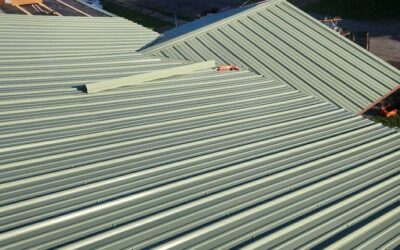How to Fix a Roof: The Ultimate Guide to Roof Repair
A well-maintained roof is crucial for protecting your home from the elements. Over time, wear and tear, weather conditions, and other factors can lead to damage that requires attention. Whether you’re dealing with a leaking roof, missing shingles, or general wear, understanding how to fix a roof is essential to prevent further damage. In this comprehensive guide, we will walk you through how to identify roof issues, the necessary tools for fixing your roof, and step-by-step instructions on how to perform roof repairs safely and effectively.
Why Roof Maintenance is Important
Your roof serves as the first line of defense against the elements. It protects your home from rain, snow, wind, sun, and other weather conditions. Without a well-maintained roof, your home is susceptible to water damage, mold growth, structural weakening, and even health hazards. Fixing your roof promptly when issues arise is key to preventing more serious (and expensive) problems down the road.
Common roof issues that require fixing include:
- Leaks: Leaking roofs can be caused by damaged shingles, flashing, or vents, and need to be repaired quickly to avoid water damage inside your home.
- Cracked or Missing Shingles: Shingles can crack or blow off due to storms or age, leaving your roof vulnerable to further damage.
- Clogged Gutters: Gutters that are clogged with debris can cause water to pool on the roof, leading to potential leaks or damage to the roof structure.
- Damaged Flashing: Flashing around chimneys, skylights, and vents can deteriorate over time, leaving those areas vulnerable to leaks.
Regular roof inspections are the key to catching these issues early. If you spot problems, addressing them quickly will help you avoid costly repairs or a full roof replacement.
How to Identify Roof Problems
Before diving into roof repairs, it’s essential to identify the specific issue. Here are the common signs that your roof may need fixing:
1. Water Stains on Ceilings or Walls
Water stains on your ceilings or walls are a telltale sign that your roof is leaking. If you notice discolored patches or bubbling paint, it’s important to inspect your roof for damaged shingles or flashing.
2. Missing or Damaged Shingles
If shingles are missing, cracked, or curling at the edges, your roof is likely no longer fully protected. Missing shingles can leave the underlying structure exposed to the elements, leading to leaks or water damage.
3. Sagging Roof
A sagging roof is a serious issue. It could indicate a structural problem, often related to water damage, where the weight of the water has caused the roof deck to bow. This issue requires immediate attention from a professional roofer.
4. Granules in Gutters
If you notice a large number of granules from shingles in your gutters, it’s a sign that the shingles are deteriorating. Over time, this can lead to exposed roof areas, increasing the risk of leaks.
5. Moss or Algae Growth
Moss and algae growth on your roof could indicate trapped moisture. This often happens in shaded areas where water doesn’t dry up quickly. While not always a major issue, this can lead to rotting shingles over time.
6. Damaged Flashing
Flashing is used to seal joints and prevent water from entering through cracks or seams. If your flashing is cracked, rusted, or otherwise damaged, it could lead to leaks around skylights, chimneys, or vents.
Tools and Materials You’ll Need to Fix a Roof
Fixing a roof requires the right tools and materials. Here’s a list of what you’ll need to tackle roof repairs safely and effectively:
Essential Tools:
- Ladder: A sturdy ladder is essential for reaching the roof safely. Make sure it’s in good condition and tall enough to reach the roofline.
- Roofing Nails: Used to secure shingles to the roof decking.
- Hammer or Roofing Nail Gun: A hammer is the most basic tool for nailing shingles, but a roofing nail gun can speed up the process.
- Utility Knife: Used to cut shingles, roofing felt, and other materials to size.
- Pry Bar: Used for removing old shingles, flashing, and nails.
- Caulk Gun: For applying roofing sealants or tar.
- Roofing Cement or Sealant: A thick adhesive used to seal roof repairs, especially around flashing, vents, or chimneys.
- Replacement Shingles: If you have missing or damaged shingles, you’ll need to replace them with new ones.
- Roofing Felt: Used to cover areas that need temporary protection from the elements while waiting for permanent repairs.
- Work Gloves: Protect your hands from sharp objects and rough materials.
- Safety Harness: If you’re working on a steep or high roof, a safety harness is essential to prevent falls.
Materials for Roof Repair:
- Asphalt Shingles: The most common type of roofing material for residential homes. Make sure you choose the right color and style to match your existing shingles.
- Roofing Felt or Underlayment: A protective layer that goes beneath the shingles to prevent water from seeping through.
- Flashing: A material that seals joints and edges on the roof, preventing water from entering.
- Roofing Cement: Used for sealing cracks or leaks around flashing, vents, or chimneys.
Step-by-Step Guide to Fixing a Roof
Now that you’ve identified the problem and gathered the necessary tools, it’s time to start fixing your roof. Here’s a step-by-step guide to help you with common roof repairs:
Step 1: Inspect the Roof
Before making any repairs, inspect your roof thoroughly to locate the source of the problem. Use a ladder to carefully climb up to the roof and look for damaged or missing shingles, broken flashing, or other visible issues. It’s important to wear safety gear, such as a harness, if you’re working on a steep or high roof.
Step 2: Remove Damaged Shingles
If you have damaged or missing shingles, they need to be replaced. Use a pry bar or roofing shovel to carefully remove the old shingles. Start at the edge of the damaged area and work your way toward the ridge. Remove any nails and lift the shingles off the roof.
Step 3: Apply Roofing Felt
After removing the damaged shingles, it’s essential to apply roofing felt to the exposed roof decking. This will act as a protective layer until you install new shingles. Lay the roofing felt flat, overlapping each layer by about 6 inches. Secure it with roofing nails.
Step 4: Install New Shingles
Start at the bottom edge of the roof and work your way up. Place the first row of shingles, overlapping them by about 5-6 inches. Use roofing nails to secure each shingle in place, making sure not to drive the nails through the shingle’s surface. Continue installing shingles, making sure each row overlaps the one below it.
Step 5: Replace Flashing
If the flashing around vents, chimneys, or skylights is damaged, it needs to be replaced. Remove the old flashing and clean the area before installing the new flashing. Apply roofing cement around the edges to create a watertight seal.
Step 6: Seal the Repairs
Once all the repairs are complete, use roofing cement or sealant to seal any joints, edges, or seams that could be prone to leaks. Apply the cement with a caulk gun, making sure to cover all gaps and cracks.
Step 7: Inspect and Clean the Roof
After completing the repairs, inspect the roof again to ensure everything is secure and properly sealed. Remove any debris, leaves, or moss that could trap moisture and cause further damage.
Step 8: Test for Leaks
Once the roof repairs are complete, test the roof for leaks by running a hose over the repaired area. Check the attic or ceiling inside the home for any signs of water. If you notice any new leaks, recheck the repairs and add additional sealant if necessary.
When to Call a Professional Roofer
While many roof repairs can be done by a skilled DIYer, some issues may require professional assistance. It’s important to know when to call in a professional roofer to ensure the job is done correctly and safely. Here are some situations where professional help is needed:
- Major Structural Damage: If your roof is sagging, experiencing severe damage, or if the structure is compromised, it’s best to call a professional.
- Steep or High Roofs: Roofs that are too steep or high can be dangerous to work on without proper safety equipment.
- Complex Roof Systems: If your roof has multiple slopes, valleys, or unique features like skylights, working on these areas requires specialized knowledge.
- Ongoing Leaks: If you’ve tried fixing leaks yourself and the problem persists, it may indicate a more complex issue that needs professional attention.
Roof Repair Costs
The cost of fixing a roof can vary depending on the type of damage, the materials used, and whether you hire a professional or tackle the repair yourself. On average, homeowners can expect to pay:
- Minor Repairs: $150 – $400 (e.g., replacing a few shingles or sealing leaks).
- Moderate Repairs: $500 – $1,500 (e.g., replacing flashing or repairing large sections of the roof).
- Major Repairs: $1,500 – $4,000 (e.g., replacing a significant portion of the roof or repairing structural damage).
Hiring a professional roofer may increase the overall cost, but it ensures that the repairs are done correctly and safely.
Conclusion
Fixing a roof is an essential part of home maintenance that requires attention to detail and the right tools. Whether you’re dealing with a small leak or major roof damage, understanding how to address these issues will help you protect your home and avoid costly repairs in the future. Regular roof inspections and timely repairs are crucial for maintaining the integrity of your roof and ensuring your home stays safe and dry.
If you’re unsure about making roof repairs yourself or face a complex issue, it’s always a good idea to consult a professional roofer. They can assess the problem, recommend the best solution, and perform the repair work safely and efficiently.
Remember, taking care of your roof today can prevent larger issues tomorrow, preserving the long-term value and safety of your home.
 (440) 307-2060
(440) 307-2060


